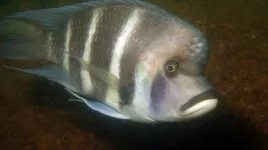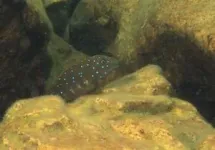(Press-News.org) Exploratory behavior is one of the fundamental personality traits of animals – and these traits influence their probability of survival, among other things. For example, curious individuals can inhabit different areas in their habitats compared to more cautious conspecifics. At the same time, however, they expose themselves to a greater risk of being discovered and eaten.
Exploratory behavior as a factor in evolution
The cichlids of Africa’s Lake Tanganyika exhibit extraordinary diversity in terms of shape, diet, habitat and coloration. This allows them to inhabit various ecological niches and therefore to engage in less competition with one another. Researchers have long suspected that also curiosity acts as a driver in the formation of new species and therefore biodiversity. Now, a research team led by Professor Walter Salzburger from the University of Basel has used the example of the extremely diverse cichlid fishes of Lake Tanganyika to investigate the role of behavioral differences in adaptation to different ecological niches.
For a total of nine months, first author Dr. Carolin Sommer-Trembo recorded the “exploratory behavior” of 57 different cichlid species at the Southern shore of Lake Tanganyika in Zambia. To this end, the zoologist made video recordings of how the approximately 700 cichlids caught in the lake behaved in a new environment in form of large experimental ponds. She then released the animals back into the wild.
Back in Basel, Sommer-Trembo used these videos to determine which areas of the experimental pond each fish explored within a 15-minute period. “On the whole, large differences in exploratory behavior were observed between the cichlid species, and these differences were also confirmed under laboratory conditions,” says the evolutionary biologist. Detailed analyses of the data revealed a strong correlation between exploratory behavior and the habitat – and body shape – of the respective cichlid species. For example, species that live near the shores, with a bulkybody shape, are more curious than elongated species living in open water. “This puts the focus back on animal behavior as driving force behind key evolutionary processes,” says Sommer-Trembo.
Specific mutations make the fish more curious
In order to investigate the genetic basis of the observed behavioral differences in cichlids, the research team worked together with Dr. Milan Malinsky from the University of Bern to develop a new method for analyzing the existing genomes that allowed them to compare data across different species.
Using their new method, the researchers identified a genetic variant in the genome of cichlids that showed a near perfect correlation with exploratory behavior: species with a “T” at this specific position in the DNA are curious, whereas species with a “C” are less exploratory.
When the researchers used the “genetic scissors” CRISPR-Cas9 to induce targeted mutations in the corresponding region of the genome, the exploratory behavior of the fish changed – they became more curious. Moreover, the team was able to use artificial intelligence and information about the genetic variant, body structure and habitat to predict the exploratory behavior of cichlid species that, initially, had not been examined for their exploratory behavior.
Implications for human behavior?
The genetic variant identified by the researchers is located in the immediate vicinity of the gene cacng5b, which shows activity in the brain. This is the “fishy” version of a gene that is also found in other vertebrates. For example, the human variant is associated with psychiatric diseases such as schizophrenia and bipolar disorders, which may in turn be correlated with personality disorders.
“We’re interested in how personality traits can affect mechanisms of biodiversity in the animal kingdom,” says Sommer-Trembo. “But who knows: ultimately, we might also learn something about the foundations of our own personality.”
END
Curiosity promotes biodiversity
2024-04-25
ELSE PRESS RELEASES FROM THIS DATE:
Warming Arctic reduces dust levels in parts of the planet
2024-04-25
Climate change is a global phenomenon, but its impacts are felt at a very local level.
Take, for example, dust. Dust can have a huge impact on local air quality, food security, energy supply and public health. Yet, little is known about how global climate change is impacting dust levels.
Previous studies have found that dust levels are actually decreasing across India, particularly northern India, the Persian Gulf Coast and much of the Middle East, but the reason has remained unclear. Researchers at the Harvard John A. Paulson School of Engineering and Applied Sciences (SEAS) are working to understand how ...
New MSU research finds paid family leave helps prevent child abuse
2024-04-25
MSU has a satellite uplink/LTN TV studio and Comrex line for radio interviews upon request.
EAST LANSING, Mich. – Child maltreatment is a serious public health issue in the United States, particularly affecting young children who are most vulnerable due to their dependence on caregivers. Infants under two years old account for over one-quarter, or 28.1%, of all maltreatment cases in the U.S., and infants under one year of age experience the highest rate of victimization, according to the U.S. Department of Health and ...
Endocrine Society names Andrews as new Editor-in-Chief of Endocrinology
2024-04-25
WASHINGTON—The Endocrine Society has appointed Zane B. Andrews, Ph.D., of Monash University in Melbourne, Australia, as Editor-in-Chief of its flagship basic science journal, Endocrinology.
Andrews has been Deputy Editor of the journal since 2020 and will be taking on this role as previous Editor-in-Chief Carol Lange, Ph.D., of the University of Minnesota in Minneapolis, Minn., transitions into her new position as the Society’s President-Elect.
“I am thrilled that Dr. Andrews is taking on this opportunity to lead Endocrinology. He has already provided immense value as the Deputy Editor. I very recently met with ...
Type of surgery and its risk level has significant impact on complications and death in elderly patients
2024-04-25
Key Takeaways
Frailty and procedure risk are both associated with increased postoperative complications and odds of death. However, certain patients are at increased risk of postoperative complications and death in comparison to the same patients who are assessed solely on their level of frailty.
Compared to frailty alone, procedure risk had a stronger association with adverse outcomes among elderly patients undergoing emergency surgery. For example, high-risk procedures resulted in an 8-fold increase in the odds of death following surgery, ...
National Center to Reframe Aging teams up with Longevity Ready Maryland Initiative
2024-04-25
The National Center to Reframe Aging — the leading organization for proven communication strategies and tools to effectively frame aging issues — is partnering with the Maryland Department of Aging in development of its multisector plan on aging, the Longevity Ready Maryland Initiative.
The National Center will be a strategic partner providing guidance in Maryland’s statewide campaign to advance an equitable and complete story about aging and promote proven communication strategies to frame aging issues. Key leaders and staff of the Maryland Department of Aging will participate in educational opportunities and receive resources to consistently apply ...
Study reveals racial disparities in COVID-19 testing delays among healthcare workers
2024-04-25
At the height of the pandemic, timely access to COVID-19 testing was crucial for curbing the spread of the disease and informing treatment decisions. Studies have unveiled racial and ethnic disparities in COVID-19 infection rates, clinical outcomes, and access to treatment and testing. However, until now, there has been a gap in research specifically examining the connection between race, ethnicity, and delayed COVID-19 testing amongst health care personnel.
Researchers from Brigham and Women’s Hospital, a founding member ...
Estimating emissions potential of decommissioned gas wells from shale samples
2024-04-25
UNIVERSITY PARK, Pa. — Extracting natural gas from shale formations can provide an abundant, lower-carbon footprint fossil fuel, but also creates concerns over increased methane emissions. A team led by Penn State researchers has developed a new tool that can estimate the emission potential of shale wells after they are no longer active.
The findings, published in the journal Science of the Total Environment, revealed that methane begins diffusing from the shale formation after a well is decommissioned and that this represents a notable source of methane ...
Nanomaterial that mimics proteins could be basis for new neurodegenerative disease treatments
2024-04-25
MADISON — A newly developed nanomaterial that mimics the behavior of proteins could be an effective tool for treating Alzheimer's and other neurodegenerative diseases. The nanomaterial alters the interaction between two key proteins in brain cells — with a potentially powerful therapeutic effect.
The innovative findings, recently published in the journal Advanced Materials, were made possible thanks to a collaboration between University of Wisconsin–Madison scientists and nanomaterial engineers at Northwestern ...
ASC scientists released long-term data of ground solar-induced fluorescence to improve understanding of canopy-level photosynthesis
2024-04-25
In recent years, the scientific community has increasingly turned its attention to sustainable agriculture, aiming to maximize crop yield while minimizing environmental impact. A crucial aspect of this research involves understanding the fundamental processes of plant photosynthesis and how they can be monitored at scale. One promising method for assessing photosynthetic activity is through the measurement of sun-induced chlorophyll fluorescence, a byproduct of photosynthesis that can be detected ...
Study uncovers drug target in a protein complex required for activation of NF-κB, a transcription factor involved in multiple diseases
2024-04-25
RESEARCH SUMMARY
Study Title: Positive selection CRISPR screens reveal a druggable pocket in an oligosaccharyltransferase required for inflammatory signaling to NF-κB
Publication: Cell (4/25/24)
Dana-Farber Cancer Institute authors include: William Kaelin, Jr, MD, senior author; Benjamin Lampson, MD, PhD, first author; Lixia He, PhD; Jamie Pfaff, MD; Nitin Shirole, PhD; and Yanfeng He, PhD
Summary: A new paper by Dana-Farber Cancer Institute ...





